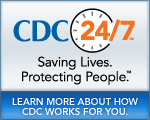MMWR – Morbidity and Mortality Weekly Report
MMWR News Synopsis for November 10, 2010
- Great American Smokeout — November 18, 2010 (Box)
- Racial, Ethnic, and Geographic Disparities in Lung Cancer Incidence — 38 States, 1998a€“2006
- Increasing Prevalence of Parent-Reported Attention-Deficit/Hyperactivity Disorder Among Children — United States, 2003 and 2007
- Neonatal Intensive-Care Unit Admission of Infants with Very Low Birth Weight — 19 States, 2006
There is no MMWR telebriefing scheduled for November 10, 2010.
1. Great American Smokeout — November 18, 2010 (Box)
CDC Division of News and Electronic Media
(404) 639-3286
No summary available.
2. Racial, Ethnic, and Geographic Disparities in Lung Cancer Incidence — 38 States, 1998a€“2006
CDC Division of News and Electronic Media
(404) 639-3286
Lung cancer is the second most commonly diagnosed cancer and the leading cause of cancer-related death in the US. CDC reports lung cancer incidence variation among racial/ethnic groups by geographic region. Among whites, the highest lung cancer incidence rate was in the South; incidence rates among blacks, American Indians/Alaska Natives, and Hispanics were highest in the Midwest; rates among Asian/Pacific Islanders were highest in the West. These variations may be due to regional differences in smoking prevalence, exposure to carcinogens and other factors. Lung cancer prevention efforts including tobacco control, increasing referrals to tobacco cessation quitlines, decreasing carcinogen exposure, and surveillance of lung cancer incidence and smoking prevalence are currently conducted by CDC, and should be continued to reduce disparities.
3. Increasing Prevalence of Parent-Reported Attention-Deficit/Hyperactivity Disorder Among Children — United States, 2003 and 2007
CDC Division of News and Electronic Media
(404) 639-3286
Rates of parent-reported ADHD diagnosis are increasing and the patterns of ADHD diagnosis are changing in the United States. We now have 5.4 million children who have been diagnosed with ADHD and 2.7 million are currently taking ADHD medication. That is nearly one in ten school age children with an ADHD diagnosis. Of those with a current ADHD diagnosis, approximately two-thirds were taking medication for ADHD. The findings of this report indicate that a million more children 4-17 years of age had a parent-reported ADHD diagnosis by 2007 as compared to 2003. That's a 22 percent increase in ADHD diagnosis in four years. In addition, significant increases in rates of ADHD diagnosis among older teens and Hispanics suggest that health care providers may be managing a larger and different demographic than they were four years ago. CDC will continue to investigate the variability noted in this report in order to characterize the public health impact of ADHD and improve the outcomes of children and families impacted by this disorder.
4. Neonatal Intensive-Care Unit Admission of Infants with Very Low Birth Weight — 19 States, 2006
CDC Division of News and Electronic Media
(404) 639-3286
This study showed that nearly 1 in 4 infants with very low birth weight included in the study did not receive neonatal intensive care unit (NICU) services at birth. CDC knows from previous studies that neonatal intensive care can increase survival among infants with very low birth weight by as much as 24 percent. There were large differences between states in NICU admission among infants with very low birth weight. Because every state is different, barriers to infants with very low birth weight receiving NICU care should be studied and addressed at the individual state level.
- Historical Document: November 10, 2010
- Content source: Office of the Associate Director for Communication, Division of News and Electronic Media
- Notice: Linking to a non-federal site does not constitute an endorsement by HHS, CDC or any of its employees of the sponsors or the information and products presented on the site.
View Press Releases in
Get e-mail updates
To receive e-mail updates about this page, enter your
e-mail address:
Contact Us:
- Centers for Disease Control and Prevention
1600 Clifton Rd
Atlanta, GA 30333 - 800-CDC-INFO
(800-232-4636)
TTY: (888) 232-6348 - Contact CDC-INFO


